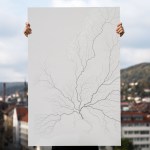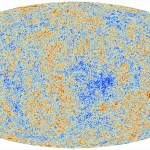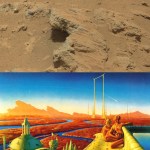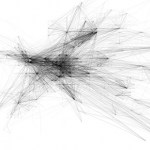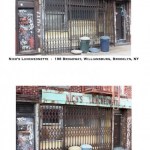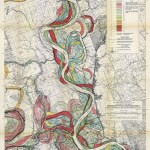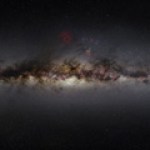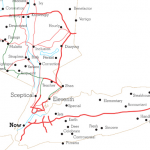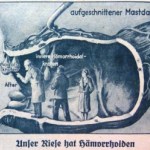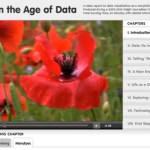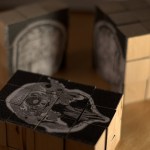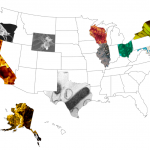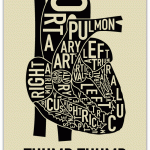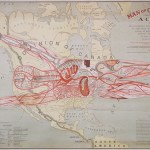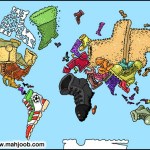Maps
Roads to Rome
All roads really read to Rome
moovel lab makes funky maps,
go play
"I have an existential map. It has 'You are here' written all over it." -Steven Wright
So just because the Ask Ethan series is becoming way more popular than I can handle -- I've got more than 200 questions that I'm sitting on by now -- doesn't mean you should stop sending your questions! There are some really good ones, and today's comes from Robert Plotner, who asks:
When maps of the CMB are depicted, they are shown as a flattened ovoid. How does this correlate to our view of the sky which is a sphere? For example, a global map of the Earth is either distorted to show it in two dimensions…
The space-heads among you have undoubtedly heard about the Curiosity rover's first significant discovery: the remnants of an ancient streambed on Mars, which would seem to indicate the presence of water in the planet's history. This jagged pile of alluvial rock and dust may not look like much, but it brings to mind one of my favorite pieces of Martian historical arcana.
For a time in the late 19th century, it was believed that there were canals on Mars.
The Italian astronomer Giovanni Schiaparelli, who observed Mars in 1877, was the first to describe, name, and lovingly illustrate…
William Gibson, first in his novel Burning Chrome and then later in the seminal Neuromancer, both coined and defined "cyberspace" as "a consensual hallucination experienced daily by billions of legitimate operators." His novels predate the universal adoption of the World Wide Web as a communication matrix, and his psychedelic fantasy of cyberspace–a kind of semantic space navigated by users in virtual-reality, where information takes form as navigable structures–is not quite (yet) our web, but he was correct in his estimation of the network as a hallucination.
Most of us know, on some…
This video from Xperia Studio very effectively conveys how data visualization can both leverage and challenge our conceptions of "reality." The night sky we've seen since childhood, like everything else we see, is just a tiny slice of the spectrum - only what we can perceive with our limited physiology. An app that lets us "see" otherwise invisible wavelengths is not merely a prosthesis that cleverly enhances our sensory perceptions, it's a tool to expand our worldview, by reminding us that what we see is only a limited subset of the whole: we could as easily see quite a different world, and…
Photo of Vermont highway courtesy of Kyle Cornell
Last week, I had my long-awaited vacation semi-ruined when, thanks to Hurricane Irene, my flight back from the West Coast was cancelled. I had to rent a car and drive across the country in a rush - not my favorite way to spend three and a half days. But based on what I saw passing through New York, and what I've heard about the damage in Vermont, I can't complain: flooding has overturned homes, isolated entire towns, and destroyed everything some families own.
Vermonters are a notoriously self-sufficient bunch, and I haven't seen that much…
Gold Cortex
16 x 20, 2010
Greg Dunn
I used to have a beautiful gold Japanese folding screen, which was purchased by my great-grandmother's feisty sister on a trip in the 1920s. I loved the gold patina and the surprisingly modern impact it had on my wall. At the moment, it's loaned to a friend, but looking at Greg Dunn's artwork, I couldn't help but be reminded of the best aspects of my screen: the gold leaf, crisp black patterns, and way that the scene seemed half natural, half abstract.
The biggest twist Greg, a 6th year graduate student in neuroscience at the University of Pennsylvania,…
Nick's Luncheonette
Randy Hage
Via the eye-candy blog How to Be a Retronaut (thanks Miles for first sending me a link there), the painstakingly accurate miniature Manhattan streetscapes of LA artist Randy Hage are half-toy, half-historical document - a wonder cabinet of urban curiosities.
Hage's overarching goal is to preserve rapidly disappearing streetscapes. As he told Jeremiah Moss at Vanishing New York,
I remember one instance in particular that prompted me to seriously focus on this project. I was on my way to revisit a Brooklyn donut shop that I had photographed a year earlier. I…
Via Alexis Madrigal's Mississippi explainer at the Atlantic, this beautiful map of the Mississippi's historic meanderings is like a carelessly draped cluster of silk ribbons. Madrigal says,
If the Mississippi were allowed to do what it wanted, what is now the Atchafalaya River would become the new ending of the Mississippi. Again, in a purely natural world, that would be a six of one, half dozen of the other situation. But now human systems depend on the Mississippi remaining roughly as it was in 1900 when we started to build massive amounts of infrastructure.
As you can see, the river is a…
If you haven't already seen the Photopic Sky Survey, you really should. Nick Risinger toured the world's least light-polluted sites to photograph and stitch together this 37,440 exposure, 5000 megapixel image of the night sky. I honestly don't think I've ever appreciated the sheer number of stars out there as much as I did this morning, zooming in on Nick's amazing panorama. Someone really needs to mash this up with a Carl Sagan monologue or something, because anything I could say about our relative insignificance in the universe would be inadequate.
I get mail with wonderful links in it, but I'm hard pressed to find the time to post them, so my apologizes to those who've sent me things and not heard back. I'm beyond swamped. In the meantime, perhaps you'll enjoy these two nontraditional takes on "mapping." First up, map as music (or is it vice versa?):
"Conductor" by Alexander Chen
Conductor turns the New York subway system into an interactive string instrument. Using the MTA's actual subway schedule, the piece begins in realtime by spawning trains which departed in the last minute, then continues accelerating through a 24 hour loop.…
Observatory is hosting another great event tonight:
From Heumann Heilmittel, "Eine Reise durch den menschlichen Körper" (1941)
Body Voyaging: an illustrated lecture with Kristen Ann Ehrenberger
Date: TONIGHT, Monday, January 17th
Time: 8:00 PM
Admission: $5
Presented by Morbid Anatomy
We human beings have a seemingly insatiable desire to experience the bodies underneath our skins. While many scholars have treated the subject of looking into or through bodies via medical imaging, one perhaps understudied trope is that of "body voyaging." A few writers and artists have imagined what it…
Knight Fellow Geoff McGhee created this polished video documentary series about how data visualization is infiltrating and transforming journalism. Interviews with Many Eyes creators Fernanda Viegas and Martin Wattenberg, Amanda Cox of the New York Times, and other dataviz luminaries are coupled with bios and links to further information, some history of visualization techniques, industry context (is dataviz profitable? who's doing it?) and lots of lovely examples. The last section of the video, "First Steps," is a mini-tour of useful DIY sites like Swivel and Wordle (which is ridiculously…
Der Mensch als Industriepalast [Man as Industrial Palace] from Henning Lederer on Vimeo.
So awesome! Fritz Kahn's poster reimagined as an animation by Henning Lederer. Via Bora.
Somebody in charge of pulling flickr illustrations for Wired's website has a good eye - they used this photo by Stephen Hampshire. A quick visit to flickr, and it turns out the photo is of Hampshire's homemade version of a DIY project originally described by Neil Fraser: a wooden cube brain map/puzzle. Fraser summarized his creation thus:
Last month I took a left-right MRI scan, reconstructed it, and rerendered top-bottom and front-back scans. It was interesting to manipulate the data and extract information which while previously present, was not previously visible. Another method to…
I've had some great suggestions for "Official" State Microbes in comments and via twitter. I'm filling in the map as they come:
So far we have:
Alaska -- Alcanivorax borkumensis for its oil consumption
California -- Ralstonia metallidurans for its gold precipitating qualities (and CA-MRSA as a terrifying runner up)
Illinois -- Penicillium roqueforti for its blue cheese making
Maryland -- Chlamydia trachomatis for UMD research on the bug
Massachusetts -- Escherichia coli for its importance to biotech
New York -- Pseudomonas putida, the first organism to be the subject of a patent case, which…
*That's the Amazon rainforest - not Amazon.com!
Check out this interview from MAKE with Google's Rebecca Moore, who helped an Amazon chief use Google Earth to fight illegal logging.
Lots more here.
As a fan of maps, typography, and anatomy, I think this is a pretty sweet mashup.
From orkposters.com via Street Anatomy.
Another fabulously weird map, from the great blog Strange Maps. This one is entitled "The Man of Commerce" and dates to 1889.
According to the American Geographical Society Library,
The highly detailed 31" x 50" map/chart conflates human anatomy with the American transportation system, in an apparent attempt to promote Superior as a transportation hub.Its metaphor makes West Superior "the center of cardiac or heart circulation"; the railways become major arteries; and New York is "the umbilicus through which this man of commerce was developed."The explanatory notes conclude: "It is an…
I have a feeling that this is what Isis sees when she looks at a map. Only with sexier shoes, of course.
From one of my new favorite blogs - Strange Maps. Thanks to Jake for the find.
